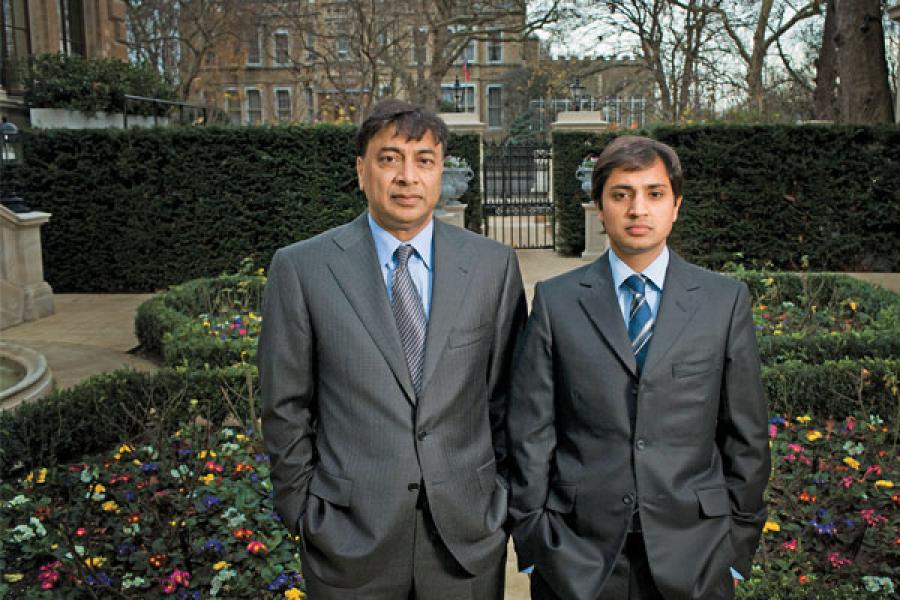
The Year That Was: Mr.Steel's Moment of Truth
The iconic success story of Lakshmi Mittal has entered a nightmarish chapter. For a happy end, he must defeat the goblins of debt, vanishing demand and mills that are gluttons for cash
On April 29, 2009, at a conference call with analysts and journalists from around the globe, Lakshmi Niwas Mittal spoke about the slump in the global steel market and the mound of debt that burdened ArcelorMittal. He had the unpleasant job of announcing the second straight quarter of losses in his business empire that had never made a loss before.
The most urgent threat: A potential breach of the debt covenants. Under a commitment to his bankers, Mittal must make one dollar of EBITDA (earnings before interest, tax, depreciation and amortisation) for every $3.5 of debt he carries. When the profit falls, he should bring down debt or pay penalty. Given that he had amassed $27 billion in debt, he should be making an EBITDA of $7.6 billion a year. He isn’t making it and isn’t likely to make it in the near future.
Yet, industry veterans reckon that Mittal might turn the challenge into an opportunity by restructuring his empire and shedding some fat. The Mittal solution will be three-pronged. First, he will effect cost-cutting measures across factories, conserve cash and pay off some debt. Next, he will start producing more in low-cost factories and less in high-cost ones. Then, he will seek a more decisive entry into emerging markets where much of the future demand for steel could come from.
Across his steel empire, the likelihood of plant closures, shutdowns and layoffs have already begun to spook trade unions and workers. Mittal will find Europe a more vigorous opponent of his cost-cutting than any other geography.
While frugality will bring in some cash, it will nowhere be enough to rid ArcelorMittal of the debt problem entirely. Mittal would have to raise money. Very little is likely to come from the sale of steel.
Mittal has announced a rights issue to raise $3 billion. The money will help pay off some of the debt. But the fact that ArcelorMittal has resorted to raising equity shows that it is not confident of meeting the debt covenants through cash flow.
Mittal has lots and lots of steel making capacity, but not all of it efficient in terms of cost or proximity to high-growth markets. His plants in the US and Europe account for 60 percent of the total capacity, but are also the costlier ones. He will have to scale down production there and utilise other plants in places like Kazakhstan, Ukraine and Mexico.
Though any plans to shut production in Europe could become a political fireball (in the US, he would be able to explain it better), there is a rationale for cutting production in mature markets. Mittal has ample presence in those markets where demand is stagnating and has scant presence in the regions that will ooze demand in the future. Brazil, Russia, India and China are the new growth regions for steel. ArcelorMittal is yet to own a steel-making unit in Russia or India. It only has a 10-million-tonne capacity in Brazil. In China, Mittal has been struggling to make a mark.
If he manages to reduce his debt, prune inefficiencies and wait just long enough for steel demand to revive, Mittal may become a still bigger icon for entrepreneurship.
(Edited by S. Srinivasan)
-This article was earlier published in Forbes India magazine dated June 5, 2009. WHY DID WE DO THE STORY
As we were preparing for the inaugural issue of Forbes India, we were struck by the monumental events around us what with the recession still holding. The mood was somber all over.
In such a world, there were many crisis stories to be told and we had to choose wisely. But no story captured the enormity of the impact of the recession, its widespread damage on business confidence and the complexity of pulling back from the brink as the story of Lakshmi Mittal did. As the tycoon who built the world’s first truly global steel company said, “Most people will not have witnessed anything like this during their careers so far.”
The alarm came when ArcelorMittal made losses in two consecutive quarters for the first time in its history. A closer look revealed his operations were based exactly where the recession had hit the most and were absent in markets where the future growth was enormous. Mittal faced labour unrest, the risk of violating debt covenants and falling commodity prices. Mittal’s biggest crisis in his career and his plan to make a comeback were too gripping a story that we couldn’t miss.
WHERE DOES THE STORY STAND
Just like exactly a year ago, the weather on April 29, 2010, under the London sun was largely clear, if occasionally cloudy. Even the Icelandic ash has cleared. And at ArcelorMittal’s head office, things couldn’t have been sunnier. The company has returned to profits and reduced its debt by nearly a fourth. Mittal has even climbed three places on the Forbes Rich List from a “lowly” eighth spot last year.
Mittal now produces more in his low-cost plants and has cut output in expensive ones. He slashed jobs, cut costs and oversaw a series of record finance raising exercises.
But in some ways, things have remained the same for Mittal. Europe, which accounts for half of his revenues, has only sunk deeper in crisis. He continues to be over-dependent on low-growth mature markets.
Mittal’s ambitious projects in India are stuck in bottlenecks. One way out for him may be to make small acquisitions like his stake purchase in Uttam Galva Steels earlier this year.
(This story appears in the 04 June, 2010 issue of Forbes India. To visit our Archives, click here.)
Post Your Comment















